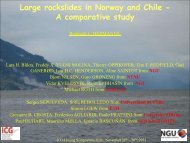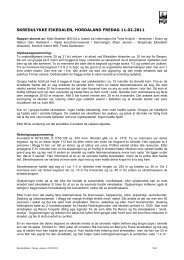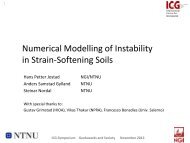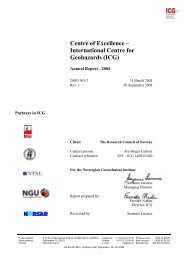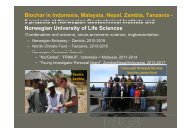Engineering monitoring of rockfall hazards along transportation ...
Engineering monitoring of rockfall hazards along transportation ...
Engineering monitoring of rockfall hazards along transportation ...
Create successful ePaper yourself
Turn your PDF publications into a flip-book with our unique Google optimized e-Paper software.
938 M. Lato et al.: Using mobile terrestrial LiDAR for <strong>rockfall</strong> hazard analysisFig. 4. Differential GPS data collection as employed by the TITANsystem. The system is comprised <strong>of</strong> a network <strong>of</strong> satellites andground receivers.Fig. 5. GPS – INS – LIDAR sensors work in concert to produceglobally registered and locally accurate point clouds.Due to the vibration and movement <strong>of</strong> the vehicle, complexmovements <strong>of</strong> millimetres and centimetres per secondare superimposed on the overall vehicle path. As a result, asimple interpolation between GPS positions (collected onceper second) is inadequate for properly positioning each Li-DAR data point. An INS, consisting <strong>of</strong> coupled gyroscopesand accelerometers, is used to solve this problem, and, in addition,the INS also provides path reconstruction during shortintervals when GPS is unavailable due to obstructed views <strong>of</strong>the sky (Yang and Farrell, 2006). Importantly, the presence<strong>of</strong> an INS means that TITAN is capable <strong>of</strong> scanning shorttunnels and underpasses or canyons without loss <strong>of</strong> precision.The relative roles <strong>of</strong> GPS and INS are illustrated inFigs. 4 and 5.Globally referenced LiDAR data inherently has two associatedaccuracy values, commonly known as local and globalaccuracy. Local accuracy is primarily a factor <strong>of</strong> sensor error– which is the observed error <strong>of</strong> the LiDAR sensor itself.For TITAN data, this error is roughly 1 cm per 100 mdistance between the object and the sensor. Global accuracyis dependent on the GPS-INS solution as well as theLiDAR sensor error, and is a measure <strong>of</strong> how well the determinedlocations <strong>of</strong> 3-D points match their true geographiclocations. Global accuracy decreases as the distance fromthe differential GPS base station increases, at a maximumrate <strong>of</strong> 0.5 cm per 1 km with an initial error <strong>of</strong> 5 mm; thisis calculated at 0.5 cm+5 ppm (Glennie, 2007b). A generalbut thorough overview <strong>of</strong> accuracy considerations for mobileterrestrial mapping was conducted and published by Barberet al. (2008). Global accuracy does not affect the viewabilityor the analysis <strong>of</strong> the data, only the relation <strong>of</strong> theidentified features to their true locations in space, and so toother GIS datasets. It is essential for the geotechnical use <strong>of</strong>this data that the data collection errors be minimized. If thedata are going to be used for orientation-based measurementsthe errors will propagate through subsequent analyses as discussedby Buckley et al. (2008).1.2 Mobile terrestrial LiDAR data and static dataConventionally, LiDAR data is collected from static platformssuch as tripods or from mobile aerial vehicles. Datadensities range from 10 000 pts/m 2 for static systems anddown to 10 pts/m 2 for aerial systems. TITAN employs staticscanning technology (via Riegl sensors) on a mobile (truck)platform. The resultant data densities practically range from50 to 500 pts/m 2 (depending on velocity). Figure 6 illustratesa direct comparison <strong>of</strong> data collected with a static LeicaHDS 6000 system and the TITAN system. The LeicaHDS 6000 collects up to 500 000 pts/s at a density <strong>of</strong> up to10 000 pts/m 2 . Figure 6 also illustrates the cross-sectionalcontinuity <strong>of</strong> the datasets and the ability to combine datafrom separate scans to increase viewability while minimizingocclusion, which are zones <strong>of</strong> no data due to obstruction.Figure 6 illustrates that the data collected by the TITANsystem displays slightly greater local noise in comparison tothe Leica data; as well it is more challenging to visualizedue to the reduced point density. However, it is sufficient toperform accurate geomechanical structural analyses as willbe demonstrated below. Data are processed using PolyWorks(InnovMetric, 2008).1.3 Feature extraction and inventory from LiDAR dataSpatially accurate LiDAR data can be used to semiautomaticallymeasure physical features typically measuredby hand in the field. From a geotechnical perspective, measurementsthat can be rapidly acquired from LiDAR data include:slope angle and geometry, ditch height, width, andangle, and track geometry parameters such as curvature. Aswell, geomechanical structural data can be assessed in termsNat. Hazards Earth Syst. Sci., 9, 935–946, 2009www.nat-<strong>hazards</strong>-earth-syst-sci.net/9/935/2009/





